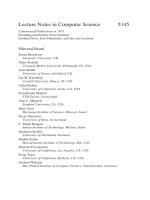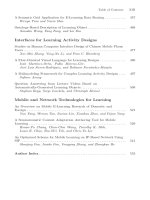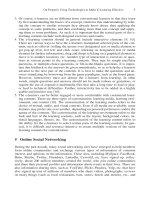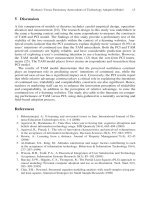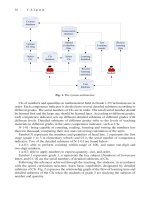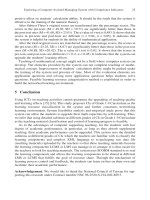Lecture Notes in Computer Science- P21 pot
Bạn đang xem bản rút gọn của tài liệu. Xem và tải ngay bản đầy đủ của tài liệu tại đây (184.79 KB, 5 trang )
90 Y T. Carolyn Yang et al.
more teachers to participate our program. Due to these arrangements for training, we
influenced more than 16,000 elementary, junior, and senior high school teachers and
more than 10,000 students to learn from the PBL.NET. (Note: The number was con-
servatively calculated by this formula: the influenced people = the registered people on
the PBL.NET * 3.) So far, all cities and counties in Taiwan have LFs, coaches, teachers,
and schools that have been influenced by the program.
Besides being responsible for the training of LFs, we also offer financial support for
the regional training of coaches, and for the administration and materials for LFs. In
order to improve the results of the training, we encourage teachers to design their own
WebQuest lessons. After the training for all levels is finished, we will hold a competi-
tion and offer some prizes for those teachers with high quality performance.
4 Design of Training Material for the Peer Coaching Program
The training materials have basically been adopted from the original Peer Coaching
materials, with some parts localized such as WebQuest lessons. Moreover, we have
also incorporated some professors’ expertise and practical experiences. We have al-
ready finished the design of the training materials for the LFs. As to the training ma-
terials for coaches, there will be some modifications depending on how the training for
the LFs proceeds. Table 1 is a list of the areas that are covered in the materials both for
the LFs and for the coaches.
Table 1. Training subjects, abstract and training hours
Subjects
Training
Hours
Abstract
Introduction of Peer
Coaching Program in
Taiwan
LF: 3 hrs
Coach: 1hr
The introduction of digitalized learning
environment, learning community, purposes,
implementation method, organization structure,
and evaluation method for the Peer Coaching
Program in Taiwan.
Knowledge
Management and
Learning Community
System
LF: 3 hrs
Coach: 1hr
The introduction of online platform design and
system construction, the functions of knowledge
management and learning community, and the
functions of teaching and class management.
WebQuest
LF: 4.5 hrs
Coach: 2hrs
The introduction of Internet learning
environment, class design strategy, scenario
teaching, and WebQuest design skills and
application.
Operational Knowledge
Management,
Community System and
Application
LF: 3 hrs
Coach: 1hr
The publication and sharing of WebQuest
material and the organization and operation of
learning community.
Coaching Skills
LF: 1.5 hrs
Coach: 1hr
The introduction of the coaching roles and
responsibilities, and the demonstration and
practice of the communication skills.
The Practice and Experience Sharing of Three-Year Peer Coaching Program in Taiwan 91
5 The Application of the PBL.NET in Professional Development
5.1 Framework of the PBL.NET
The PBL.NET ( is a website dedicated to teachers’ profes-
sional development using a peer coaching strategy. Teachers are encouraged to use the
“WebQuest Design Template”, a user-friendly WebQuest lesson editor, to design PBL
instructional materials and share them with peers in “Digital Library”. As the name
implies, “Digital Library” is a warehouse of PBL instructional materials designed by
teachers. Teachers can search the instructional materials with multiple searching ap-
proaches in the library and store selected ones in their “Teaching Pad” for reference.
The library also provides the function of peer evaluation of the artifacts. Users can
provide comments and rating for the artifacts they have used or reviewed inside the
library.
About Us
Login
Registration
Our Family Admin Tools
Digital
Library
My Office
My
Favorites
Teaching
Pad
Web Lesson
Design
Template
My
Students
Mailbox
My Study
Room
Mailbox
My
Favorites
Study Pad
My Pals
Who's Online
Ranking
System
Posting
News
Membership
Databank
Learner
Profile
Web Lesson
Repository
Annotation
&
Assessment
Learner
Profile
Web Lesson
Index &
Retrieval
Forum
Hall of Fame
Professional
Lounge
Access
Control
Log Files
Analysis
Full Text
Search
My Studio
My
Favorites
Kids'
Study Pads
Web Lesson
Design
Template
Mailbox
Learner
Profile
Fig. 3. The Platform of PBL.NET
5.2 Significance of the PBL.NET
As of October 2007, there are 3440 schoolteachers and 1090 schools using the
PBL.NET. The numbers are outstanding when they are compared with national statis-
tical data pertaining to schools in Taiwan. In other words, 2% of school teachers and
32% of schools in Taiwan already took part in the PBL.NET project. The number of
WebQuest lessons submitted by teachers is also an indication of significance. As of
92 Y T. Carolyn Yang et al.
October 2007, over 2000 WebQuest lessons were shared in the “Digital Library.” The
wealth of instructional materials in the PBL.NET is a promise of success.
6 The PBL Materials with WebQuest Design
A WebQuest is an inquiry-oriented activity in which some or all of the information that
learners interact with comes from resources on the Internet (Dodge, 1995). A Web-
Quest is a highly valued instructional strategy of constructivism during which learners
actively build their own critical understanding of a topic. Authentic or real-world
questions or problems are often researched, and learners may work cooperatively to
find solutions. Dodge proposed that creating a WebQuest is not much different from
generating any kind of lesson. It requires getting learners oriented, giving them an
interesting and doable task, giving them the resources they need and guidance to
complete the task, telling them how they will be evaluated, and then summarizing and
extending the lesson. The procedure of a WebQuest learning activity is as follows: (a)
Introduction: a good introduction makes the topic relevant to the learner’s past ex-
perience and future goals: attractive, visually interesting, and important because of its
global implications, urgent because of the need for a timely solution, and fun because
the learner will be playing a role in making something; (b) Task: a description of what
the learner will produce by the end of the exercise. It provides a goal and focus for
student energies and it makes concrete the curricular intentions of the designer; (c)
Process: the teacher suggests the steps learners should go through in completing the
task. It may include strategies for dividing the task into subtasks, or descriptions of
roles to be played or perspectives to be taken by each learner; (d) Resources: it lists web
pages and other materials pre-selected for the learner so that attention can be focused on
the topic; (e) Evaluation: a new addition to the WebQuest model to justify the expense
of using the web for learning and to be able to measure results. This rubric gives spe-
cifics in fulfilling the requirements so that there is no room for disagreeing with the
scoring; (f) Conclusion: an opportunity to summarize the experience, to encourage
reflection about the process, to extend and generalize what was learned, or some
combination of these activities.
7 Evaluation of Peer Coaching Project in Taiwan
7.1 The Purpose of Evaluation
The purpose for evaluating the Peer Coaching project in Taiwan is to understand the
opinions and suggestions of school principals, teachers, and students through a different
lens, based on which we can effectively improve the performance of the project. The
evaluation includes four surveys (Post-Unit Survey, Feedback Survey for Peer Coaching
Training, Skills and Practice Survey, and Local Facilitators’ Attitude Survey), empirical
evaluation of the research results, and interviews. Table 2 briefly displays the objective,
participants, and time of administration for each of the evaluation instruments.
The Practice and Experience Sharing of Three-Year Peer Coaching Program in Taiwan 93
We quantitatively analyzed the performance of our first-year project. To further
explore the teachers’ and students’ feelings and perspectives, a qualitative and dis-
covery-oriented interview was included in our second year evaluation. Thus, from these
two complementary instruments, we are not only able to understand the current overall
status of the project through quantitative analysis but also to qualitatively identify
participants’ thoughts and needs and identify the factors that influence the willingness
of the teachers (including LFs and coaches) who promoted this project. In addition, we
conducted vigorous empirical analysis of the research results, which showed the ef-
fectiveness of the WebQuest instructional strategy (one type of web- and inquiry-based
instructional strategy) in improving students’ higher order thinking, learning motiva-
tion, and academic achievement. Finally, in the second year, we transformed the paper
and pencil surveys into web-based surveys (using PBL.NET), greatly saving us time
and human resources and helping us to evaluate the project more efficiently and
effectively.
Table 2. The Evaluation Instruments
Evaluation Instrument
(Participants)
Objectives Format
1. Post-Unit Survey (LFs)
Investigate LFs’
understanding of the
training materials
5-point Likert Scale
2. Feedback Survey for Peer
Coaching Training (LFs)
Receive feedback on the
promotion of Peer Coaching
training
5 open-ended questions
3. Skills and Practice Survey
(LFs and Coaches)
Investigate LFs’ and
coaches’ ICT skills and their
willing to integrate ICT
skills into their instruction
7-point Likert Scale
4. Local Facilitators’ Attitude
Survey (LFs)
Investigate the LFs’
willingness and needs to
promote the Peer Coaching
project
5-point Likert Scale
Awareness of
ARCS Model
Motivation
Inventory
Investigate the effectiveness
of WebQuest on learning
motivation
35 5-point Likert Scale
questions
Critical
Thinking
Test-Level I
Investigate the effectiveness
of WebQuest on critical
thinking ability
(1) 25 multiple-choice
questions
(2) Maximum score = 25
5.
Empirical
Research
(Students)
New Problem
Solving Survey
Investigate the effectiveness
of WebQuest on problem
solving ability
15 questions
6. Interview
(Teachers and Students)
Understand teachers’ and
students’ opinions and
suggestions for taking part
in PiL project and using
WebQuest in their teaching
and learning
(1) 13 open-ended
questions for teachers
(2) 10 open-ended
questions for students
94 Y T. Carolyn Yang et al.
7.2 Results and Discussion
7.2.1 Post-unit Survey
A total of 45 LFs filled in surveys in the 2nd and 3rd years, respectively. In the 3rd year,
we cancelled “Coaching Skills” parts because teachers in the 2nd year asked to have
much time to design the WebQuest. Table 3 shows the results. We found that LFs
gained a clear understanding of the course content.
Table 3. Results of Post-Unit Survey
Topic
Area
Knowledge Management and
Learning Community System
WebQuest Coaching Skills
2nd year 4.07 4.24 4.28
3rd year 4.14 4.35
7.2.2 Feedback Survey for Peer Coaching Training
A total of 45 and 39 LFs filled in the 2nd and 3rd year survey, respectively, and pro-
vided some training suggestions as follows:
(1) Increase the time for WebQuest activities
(2) Increase the stability of the system and provide a new hard disk for file upload
(3) Provide LFs with standard workbooks and handouts
(4) Choose suitable people for training
7.2.3 Skills and Practice Survey (S & P Survey)
(1) Pretest for the 2nd and 3rd years
A total of 281 teachers filled in the survey, including 59 and 56 LFs and 82
and 84 coaches in the 2nd and 3rd years, respectively. From Figures 4 and 5,
we observed that teachers possess the ability to integrate ICT skills into their
teaching. However, they made infrequent use of this skill, which suggested
that they were capable but did not know how to integrate ICT skills into their
teaching. Therefore, in the 3
rd
year, we will focus on increasing real practice
based on ICT skills and fostering the teachers’ willingness to participate. In
addition, as shown in Figure 5, the coaches of the 3rd year have lower scores
than those of the 2nd year because most of the teachers in the 3rd year come
from remote areas such as Miao-Li and Kaohsiung Counties. We purposely
promoted this program to remote areas to bridge the digital divide between
urban and suburban areas.
(2) Pretest and posttest S & P results
In the 3rd year, from the 281 teachers in the 2
nd
and 3
rd
years, we sampled 50
LFs and 30 coaches who participated in the project over the past six months to
conduct the posttest of the Skills and Practice Survey. The results of the t-test
indicated that the pretest scores of three (S, A, and F) subscales for LFs were
